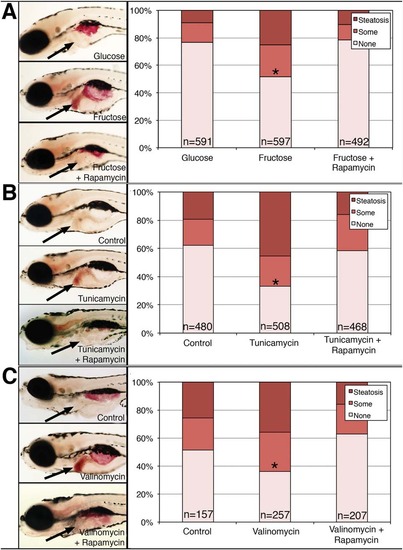Fig. 5
- ID
- ZDB-FIG-151112-3
- Publication
- Sapp et al., 2014 - Fructose leads to hepatic steatosis in zebrafish that is reversed by mTOR inhibition
- Other Figures
- All Figure Page
- Back to All Figure Page
|
Zebrafish models of NASH are mediated through mTOR. Larvae were placed in (A) 4% glucose, 4% fructose, or 4% fructose and rapamycin, or (B) control, tunicamycin, or tunicamycin and rapamycin, or (C) control, valinomycin, or valinomycin and rapamycin at 5 dpf and then examined at 7 dpf. Larvae were fixed and then stained with ORO and the amount of steatosis was quantified. (A-C) Quantification of hepatic steatosis in (A) glucose, fructose, and fructose + rapamycin-treated larvae, or control versus (B) tunicamycin- and tunicamycin + rapamycin-treated or (C) valinomycin- and valinomycin + rapamycin-treated larvae. An example of each is shown, with the liver noted by the black arrow. Note the red punctate staining in the liver of all three treatments that is not present in the larvae also treated with rapamycin. Quantification of steatosis is shown to the right, categorized as “steatosis,” “some” steatosis, or “none.” Shown are the percentages of each category in (A) glucose, fructose, and fructose + rapamycin-treated larvae, or control versus (B) tunicamycin- and tunicamycin + rapamycin-treated or (C) valinomycin- and valinomycin + rapamycin-treated larvae, and the total number of larvae in each condition is noted. The increase in larvae with steatosis or some steatosis in all three treated conditions, relative to their respective controls and relative to the rapamycin-treated conditions, is highly significant (*P ~ 0 by chi-square analysis). |
| Fish: | |
|---|---|
| Conditions: | |
| Observed In: | |
| Stage: | Days 7-13 |

